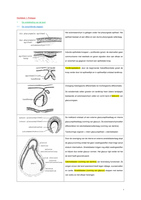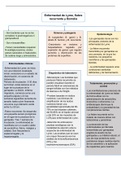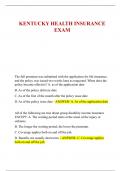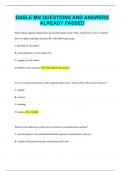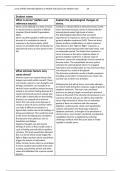BASIC CONCEPTS
1 The linguistic System
1.1 Subdisciplines of linguistics:
Language structure:
• Phonetics
• Phonology (e.g. /i/)
• Morphology (e.g. ‘un-’)
• Semantics (e.g. ‘unbelievable’)
• Syntax (e.g. ‘I think this is unbelievable.’)
• Pragmatics
Also: sociolinguistics, neurolinguistics, computational,…
The speech chain:
2 What Is Phonology?
Phonetics= “science of speech sound” (PPP: 2)
Phonology = “how sounds pattern and function in a given language”
(ib.) So what’s the difference between phonetics and phonology and what
are the different tasks for phoneticians and phonologists?
→topic of ongoing debate: in linguistic research, distinction not always clear-cut
→David Odden ‘Introducing Phonology’ (2005: 2):
« An important question is how phonology differs from the closely related discipline of
phonetics. Making a principled separation between phonetics and phonology is difficult – just
as it is difficult to make a principled separation between physics and chemistry, or sociology
and anthropology.
→common characterization of the difference:
• phonetics deals with ‘actual’ physical sounds as they are manifested in human speech (…).
• Phonology = abstract cognitive system dealing with rules in a mental grammar: principles of
subconscious ‘thought’ as they relate to language sound. (…) »
« As research in both of these fields has progressed, it has become apparent that a better understanding
of many issues in phonology requires that you bring phonetics into consideration, just as phonological
analysis is a prerequisite for any phonetic study of language » (Odden, 1995: 2)
« The relationship between phonetics and phonology has not always been symbiotic. In general
linguistics circles, phoneticians and phonologists have often accused each other of ignoring each
other’s research at their own peril. » (Major, 1998:133)
,Phonology
– abstractions from usage = linguistic knowledge
– organisation and function of sound
– language-specific
– phonemic (‘broad’) transcription
e.g. / kæt /
→studies how meaning (content) is expressed through sound in spoken language (or through gestures
in sign language)
= how sounds (phones) are grouped into distinctive units (phonemes) in language system (e.g. [k] and
[kh]→/k/)
= also meaning of sound at all levels of linguistic structure e.g. word stress, sentence stress, intonation
Phonetics
– concrete usage = realisation / manifestation of linguistic knowledge
– how sound is produced, transmitted, received
– not (necessarily) language-specific (! allophones)
– phonetic (‘narrow’) transcription
e.g. [ khæt ]
→ three main branches
1. articulatory phonetics: movements of tongue, lips, other speech organs (= ‘articulations’)
[production]
2. acoustic phonetics: physical nature of speech signal (i.e. sound) [transmission]
3. auditory phonetics: how ear receives the speech signal [reception]
→ Different aims and different method, yet closely related
3 Basic Concepts
3.1.The phoneme
Speech = continuous flow of sound: often only interruption to breathe or organise thought
“The recognition of continuous speech presents listeners (human or machine) with a problem
which does not arise in the recognition of isolated words, and does not confront the reader in
most orthographies. (…)
, → problem for listeners: lexical unit boundaries not reliably marked. Finding the boundaries
between such units – segmenting speech – = non-trivial task for all listeners”
segmentation of continuous flow in sizeable chunks → segments e.g. cat (/k/ /ae/ /t/)
→Most (native) speakers would agree on number of segments in a word: e.g. in man, 3 ‘segments’:
/m/, /æ/ and /n/
→ do not operate in isolation, but combine to form morphemes and words (or ‘lexemes’): e.g. in man,
the three segments /m/, /æ/ and /n/ have no meaning of their own, but combine to form the meaning as
parts of morphemes and words
→Different combinations of segments (can) lead to different lexical meaning
• hill /hɪl/ – pill/pɪl/ (minimal pair)
• pit /pɪt/ – pet /pet/ – pot /pɒt/ – put/pʊt/ – pat /pæt/ – part /pɑ:t/– port /pɔ:t/ – …( minimal set)
Via minimal pairs (or triplets, or sets): determine which speech sounds are phonologically significant
in a given language
→phonemes: contrastive, or distinctive, units of sound that can be used to change meaning
= smallest meaning-changing units in language
↔ smallest meaning-bearing units: morphemes
3.2.Allophonic variation
phonemes are abstract entities: linguistic representations that form part of linguistic knowledge
↔ phones are concrete sounds in actual usage
Each phoneme = generalisation that groups together phones that are interpreted as (sufficiently)
similar in their structure (i.e. articulation and acoustic pattern) and implement the same function
→each phoneme allows for variation in specific articulations / realisations: allophonic variation
→allophones: variants that a phoneme allows for (possible ways in which phoneme can be realized)
e.g. phoneme /l/ has three allophones: [l], [l̥ ] and [ɫ] (e.g. ‘lot’, ‘clean’, ‘ball’)
Phoneme /l/
Two types of allophonic variation:
, – complementary distribution (e.g. clear, dark and devoiced l)
– free variation (e.g. in Dutch, uvular (‘French’) r or alveolar, tongue-tip)
3.3 Phonemic inventory
Each language has set of phonemes that serve a distinctive (i.e. meaning-changing) function in that
language: in GB English: 20 vowels + 24 consonants (vs Dutch: 22 vowels + 20 consonants)
→different languages have different phonemic inventories
e.g. English think /θɪnk/ and breathe /bri:ð/ do not occur in Dutch
‘Scottish’ loch /lɒx/ vs English loch /lɒk/ (compare: Dutch schaap /sxa:p/)
English hit /hɪt/ and heat /hi:t/ vs. Spanish chico /'ʧiko/ or vida /'vida/ or French site /sit/
1 The linguistic System
1.1 Subdisciplines of linguistics:
Language structure:
• Phonetics
• Phonology (e.g. /i/)
• Morphology (e.g. ‘un-’)
• Semantics (e.g. ‘unbelievable’)
• Syntax (e.g. ‘I think this is unbelievable.’)
• Pragmatics
Also: sociolinguistics, neurolinguistics, computational,…
The speech chain:
2 What Is Phonology?
Phonetics= “science of speech sound” (PPP: 2)
Phonology = “how sounds pattern and function in a given language”
(ib.) So what’s the difference between phonetics and phonology and what
are the different tasks for phoneticians and phonologists?
→topic of ongoing debate: in linguistic research, distinction not always clear-cut
→David Odden ‘Introducing Phonology’ (2005: 2):
« An important question is how phonology differs from the closely related discipline of
phonetics. Making a principled separation between phonetics and phonology is difficult – just
as it is difficult to make a principled separation between physics and chemistry, or sociology
and anthropology.
→common characterization of the difference:
• phonetics deals with ‘actual’ physical sounds as they are manifested in human speech (…).
• Phonology = abstract cognitive system dealing with rules in a mental grammar: principles of
subconscious ‘thought’ as they relate to language sound. (…) »
« As research in both of these fields has progressed, it has become apparent that a better understanding
of many issues in phonology requires that you bring phonetics into consideration, just as phonological
analysis is a prerequisite for any phonetic study of language » (Odden, 1995: 2)
« The relationship between phonetics and phonology has not always been symbiotic. In general
linguistics circles, phoneticians and phonologists have often accused each other of ignoring each
other’s research at their own peril. » (Major, 1998:133)
,Phonology
– abstractions from usage = linguistic knowledge
– organisation and function of sound
– language-specific
– phonemic (‘broad’) transcription
e.g. / kæt /
→studies how meaning (content) is expressed through sound in spoken language (or through gestures
in sign language)
= how sounds (phones) are grouped into distinctive units (phonemes) in language system (e.g. [k] and
[kh]→/k/)
= also meaning of sound at all levels of linguistic structure e.g. word stress, sentence stress, intonation
Phonetics
– concrete usage = realisation / manifestation of linguistic knowledge
– how sound is produced, transmitted, received
– not (necessarily) language-specific (! allophones)
– phonetic (‘narrow’) transcription
e.g. [ khæt ]
→ three main branches
1. articulatory phonetics: movements of tongue, lips, other speech organs (= ‘articulations’)
[production]
2. acoustic phonetics: physical nature of speech signal (i.e. sound) [transmission]
3. auditory phonetics: how ear receives the speech signal [reception]
→ Different aims and different method, yet closely related
3 Basic Concepts
3.1.The phoneme
Speech = continuous flow of sound: often only interruption to breathe or organise thought
“The recognition of continuous speech presents listeners (human or machine) with a problem
which does not arise in the recognition of isolated words, and does not confront the reader in
most orthographies. (…)
, → problem for listeners: lexical unit boundaries not reliably marked. Finding the boundaries
between such units – segmenting speech – = non-trivial task for all listeners”
segmentation of continuous flow in sizeable chunks → segments e.g. cat (/k/ /ae/ /t/)
→Most (native) speakers would agree on number of segments in a word: e.g. in man, 3 ‘segments’:
/m/, /æ/ and /n/
→ do not operate in isolation, but combine to form morphemes and words (or ‘lexemes’): e.g. in man,
the three segments /m/, /æ/ and /n/ have no meaning of their own, but combine to form the meaning as
parts of morphemes and words
→Different combinations of segments (can) lead to different lexical meaning
• hill /hɪl/ – pill/pɪl/ (minimal pair)
• pit /pɪt/ – pet /pet/ – pot /pɒt/ – put/pʊt/ – pat /pæt/ – part /pɑ:t/– port /pɔ:t/ – …( minimal set)
Via minimal pairs (or triplets, or sets): determine which speech sounds are phonologically significant
in a given language
→phonemes: contrastive, or distinctive, units of sound that can be used to change meaning
= smallest meaning-changing units in language
↔ smallest meaning-bearing units: morphemes
3.2.Allophonic variation
phonemes are abstract entities: linguistic representations that form part of linguistic knowledge
↔ phones are concrete sounds in actual usage
Each phoneme = generalisation that groups together phones that are interpreted as (sufficiently)
similar in their structure (i.e. articulation and acoustic pattern) and implement the same function
→each phoneme allows for variation in specific articulations / realisations: allophonic variation
→allophones: variants that a phoneme allows for (possible ways in which phoneme can be realized)
e.g. phoneme /l/ has three allophones: [l], [l̥ ] and [ɫ] (e.g. ‘lot’, ‘clean’, ‘ball’)
Phoneme /l/
Two types of allophonic variation:
, – complementary distribution (e.g. clear, dark and devoiced l)
– free variation (e.g. in Dutch, uvular (‘French’) r or alveolar, tongue-tip)
3.3 Phonemic inventory
Each language has set of phonemes that serve a distinctive (i.e. meaning-changing) function in that
language: in GB English: 20 vowels + 24 consonants (vs Dutch: 22 vowels + 20 consonants)
→different languages have different phonemic inventories
e.g. English think /θɪnk/ and breathe /bri:ð/ do not occur in Dutch
‘Scottish’ loch /lɒx/ vs English loch /lɒk/ (compare: Dutch schaap /sxa:p/)
English hit /hɪt/ and heat /hi:t/ vs. Spanish chico /'ʧiko/ or vida /'vida/ or French site /sit/



